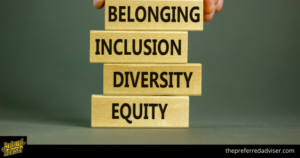Workplace diversity is not only important for your HR team, but also for everyone in the company. Diversity has more to do with communication than anything else, so it is essential for all employees to be aware of and sensitive to diversity issues.
We all know that words can be powerful, and that they can be used to hurt people, on purpose or by accident.
job maturity tests can help create a more inclusive workplace by providing a level playing field for previously overlooked minority groups.
This blog post is designed to help you communicate more effectively with people from a variety of backgrounds, which will in turn create a fairer workplace with a diverse workforce.
Diversity, Equity and Inclusion Mean in Workplace Communication
 If the makeup of your workforce is diverse, it consists of employees of different gender, race, age, sexual orientations, etc.
If the makeup of your workforce is diverse, it consists of employees of different gender, race, age, sexual orientations, etc.
An inclusive culture welcomes diversity and ensures that everyone feels comfortable communicating with one another.
Equity is the act of making sure everyone in the workplace has an opportunity to be successful.
Three Main Generations We Need to Consider in Workplace Communication
Baby Boomers
Baby boomers grew up watching TV, so they’re used to seeing mass marketing messages. They can figure out which message is right for them.
While baby boomers may still use traditional methods of communication, they have also started using social media platforms such as Facebook.
Since they’ve been watching screens for years, baby boomers are comfortable watching a short video. One of the most interesting aspects of the baby boomers is that they’re less open to change and therefore more loyal to brands they trust and like.
If customers are notified that one of their favorite brands is changing in some way, they are likely to buy that product in bulk before the changes are made.
This is important for financial advice businesses to know since many are making some radical changes this year; be mindful and always engage and communicate your reasons why more than five times.
If you have built a trusting and respectful relationship with a baby boomer client, they will most likely tell their friends about you.
Respect is important to baby boomers and they expect to be treated with respect by service providers throughout their relationship.
An example of something that would make a baby boomer angry is if you called them during lunch, dinner, or after hours. They would see that as disrespectful. Some people might think baby boomers are stuffy and boring, but that’s not true.
They look forward to retiring so they can travel and experience life, rather than sitting at home watching TV all day.
They are happy to consume your content in various ways, but when it comes to private matters, they place a great deal of value on a face-to-face meeting.
Baby boomers are more likely to respond to information that tells them what to do and makes them feel in control of their lives. This can be in the form of video, traditional marketing material, or web content.
They feel appreciated when they receive recognition, such as a thank you, VIP events, or loyalty programs. They have worked hard their whole lives and enjoy being pampered with perks and activities that make them feel like they deserve it.
Generation X
The current generation is the busiest yet, with career, family, aging parents, and other obligations. This generation remembers a time when the only way to buy something was from a store or catalogue.
If you want to reach them, just email them! They’re always attached to their computers or phone, right? Gen X was the first to see divorce as commonplace and be labeled “latchkey kids.” That’s because both parents usually worked and there was no one home after school.
As they grew up, they witnessed the introduction of mobile phones, the Internet, PCs, and social media.
Generation X is skeptical of marketing messages and advertising because they have been bombarded with them. However, once they find a brand they like, they are very loyal, just like baby boomers.
Generation X is more likely to respond to marketing that is clear about what they will get from a service or product. They want to know how it will benefit them.
A marketing strategy that uses multiple channels (such as print, digital, social media, direct mail, and television) is most likely to be successful with this generation.
Use authentic marketing to show how your advice will be valuable to them and how you have helped others like them. They are conservative and don’t want to be used as a test case.
If you want to appeal to Generation X, it would be beneficial to have a corporate social responsibility strategy for your business and to promote it.
Generation X also likes to feel part of an exclusive group, so they appreciate being invited to VIP events and experiences. However, it’s important to keep in mind that they are a busy generation.
Many people in Generation X are very aware of the importance of balancing work and life, and while some of them are still struggling with this concept, many of them have mastered it. They prefer to align themselves with businesses that share these values.
The ideal way to promote your company’s values would be to include them on your website and in your marketing materials.
Your potential clients will feel more confident in your abilities if you can tell them about your security provisions, professional qualifications, and continuing education. These credentials show that you have the skills and experience to do what you say you can do, and that you’re keeping up with new developments in your field.
Millennials
This generation contains the highest number of entrepreneurs. They are the rulers of social media and are most likely to respond to a social media strategy that is well-thought-out.
People tend to frequent businesses their friends have already been to.
Due to the fact that social proof has such a huge influence on this generation, it would be wise to have current reviews of your service on Google, Facebook, and other Internet platforms.
Millennials’ passion for interesting shows extends to podcasts as well. This is beneficial because it indicates that they are motivated to improve their lives by listening to stimulating content.
Generation X and millennials can both spot a fake from a mile away. They won’t respond to false advertising or mass media. They both want purpose and personalization.
They are more likely to respond positively to a brand that has a personality, characters, or a narrator.
Millennials are not loyal, so businesses need to work harder to demonstrate that they can provide value, benefit and a reliable outcome.
What makes millennials exciting is that they are willing to support businesses that are socially responsible, ethical, and environmentally friendly.
If you want to attract people’s interest in your advice business and make them more loyal, tell them how your business helps the community.
Customers are used to being able to shop around, not having fixed contracts, and saving money by switching companies. You need to give them a reason to stay with your company that is more than just being competitive on price.
It is clear that a robust online presence will be effective with this generation. However, it is interesting to note that this is a generation that hasn’t experienced traditional mail. So, if you want to get their attention, sending letters in the traditional way may be the best option!
A generation that is constantly communicating responds well to short, targeted messages that clearly state what is in it for them. Messages that talk only about your business without personality or entertainment will fall on deaf ears.
This is a generation with a short attention span.
Choose a digital marketing strategy that allows for real-time interaction and up-to-the-minute information to keep your audience entertained and engaged.
If you want to appeal to this generation, you need to be transparent, authentic, and real.
Tips for Embracing Diversity, Equity, and Inclusion in Communication at Work
 1. Be Aware of The Power of Words
1. Be Aware of The Power of Words
According to Kristen Donnelly, PhD, Founder at Abbey Research and a member of the Forbes Business Council, the words we use in workplace communication should be chosen carefully:
The words we use are powerful because they create meaning for ourselves in the world. If we are more intentional with how we use them in workplace settings, it will change company culture.
Naturally, this is not limited to internal communication.
Our contributor Jossie Haines advises you to be careful with your wording in your external communication as well:
It’s important to use inclusive language, especially in job descriptions. Words like “rock star” and “competitiveness” might discourage women from applying, while wording that is too compassionate and collaborative might discourage men.
2. Set Out Standards for Inclusive Language in All Communications
It is important for leaders, HR professionals, and internal communications departments to regularly share information about the advantages of having a diverse, equitable, and inclusive workplace.
This would involve creating formal policies and procedures for the use of inclusive language in all forms of communication.
In both internal and external communication, avoid using language that shows discriminatory views towards certain people or groups.
You should also not ostracize people from a group.
One of the most common examples of this inadvertent exclusion happens when people use “guys” to address a group of people, not realizing they are being insensitive to gender.
Instead of greeting people with “hello, guys,” try saying “hello, everyone,” just like Rose Waters does in Pumble.
You should avoid using metaphors that are associated with racism, as they can be Offensive. Try using more innocuous terms instead.
3. Understand Your Own Biases
 Sometimes we say things that unintentionally hurt others. These unnoticed comments, called microaggressions, contain unconscious bias towards groups that have been historically marginalized.
Sometimes we say things that unintentionally hurt others. These unnoticed comments, called microaggressions, contain unconscious bias towards groups that have been historically marginalized.
However, they are not the same as overt discrimination (or macroaggressions).
In one interview, Kevin Nadal, a professor of psychology at John Jay College of Criminal Justice, explains the difference between the two:
Rather than being intentional or deliberate, microaggressions are more likely to be the result of someone not being aware of their own biases.
When you ask an American person of color where they’re “really” from, you’re suggesting that they’re not really American, which is hurtful.
Unconscious bias can manifest in the workplace in the form of discriminatory comments. These comments can make it difficult for employees from marginalized backgrounds to feel comfortable.
The solution is to develop an inclusive communication strategy that will help your employees to become aware of their unconscious biases.
If you were to implement this policy, it would enable your employees to more effectively communicate with individuals from diverse backgrounds, and develop a more sympathetic appreciation of varied identities.
This leads us to our next tip.
4. Embrace Authenticity and Diversity
We can only create a workplace that embraces diversity when we become aware of our own biases.
We should stop viewing our colleagues as different from us, as Hawkins said.
He elaborates on that:
When incorporating inclusive language in the workplace, it is important to view everyone as equal. Our language should reflect this by avoiding terms that could be seen as discriminatory.
For example, instead of saying “Blacks” or “females”, it is better to say “Black people” or “women”. If you are unsure of what language to use, it is okay to ask.
The director of Othering and Belonging Institute at the University of California, Berkeley, john a. powell*, believes that the antonym of “othering” (treating people from another group as different and generally inferior) is in fact “belonging”.
John A. Powell believes that we should be part of the universe, not above it. He believes that using all capital letters signifies that we are above the universe.
Make your coworkers feel like they are a part of the team and that they belong instead of making them feel like outsiders.
Since the holiday season is approaching, Timothy Chalmers, a DEI consultant in a large company, is checking with his coworkers about which holidays they are celebrating, so everyone can take a day off and enjoy themselves with their family.
5. Actively Listen and Ask Questions
If you are unsure of whether a certain term is offensive and are afraid that someone might be offended by it, just ask your coworkers if it is okay to use the term.
Don’t just go through the motions with your workplace communication in order to meet a corporate requirement. Talk to your colleagues about anything you’re confused about instead.
If you’re wondering why your company is getting behind diversity, equity, and inclusion, feel free to ask.
You will only be successful in implementing your DEI initiative if you ask the right questions and communicate with your colleagues effectively.
6. Focus On Building Trust
Dr. Aditi Paul, a communication strategist and an associate professor at Pace University in New York, said that having a diverse range of people represented is the first step.
The more diverse a team is in terms of race, gender, and nationality, the more likely they are to be aware of and consider the needs of a wider range of people.
Aside from that, she highlighted another important factor for an inclusive workplace:
The corporation should encourage a culture of psychological safety, where employees feel comfortable discussing issues like discomfort, harassment, and exclusion, without fearing retribution.
This means that you should focus on creating a trusting relationship with your employees, so that they feel comfortable expressing themselves and reaching their full potential.
7. Promote Policies and Initiatives
Necessary conditions for having open conversations are to make sure that everyone is aware of:
- Company position on DEI matters,
- The expectations placed upon them, and
- The vision they are working towards.

0 comments